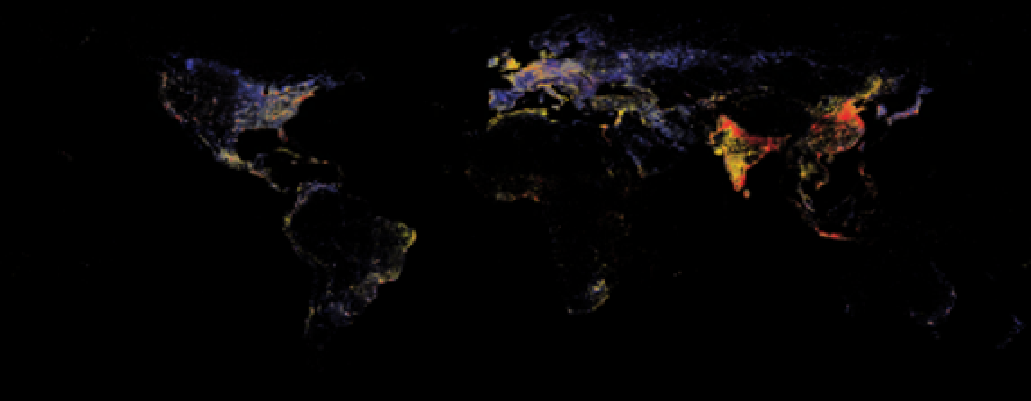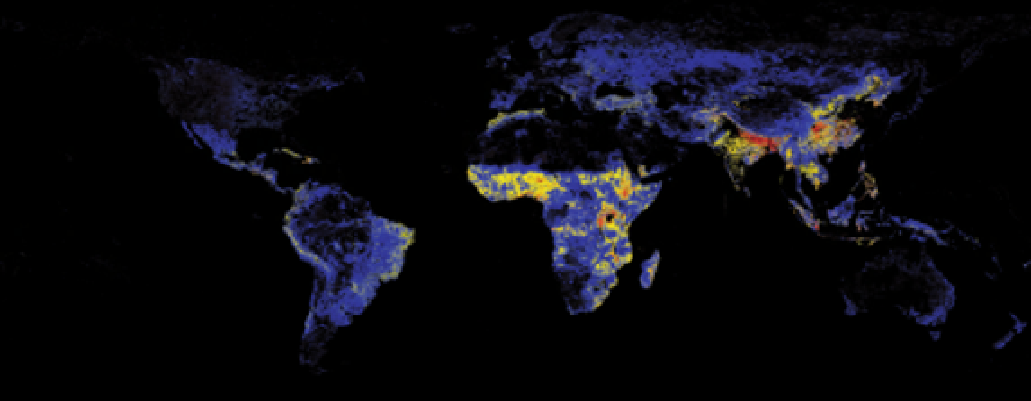Environmental Engineering Reference
In-Depth Information
FIGURE 15.3
Landscan population count in areas with DMSP detected lighting. The color coding is the same as Fig. 15.2.
FIGURE 15.4
Landscan population count in areas with no DMSP detected lighting. The color coding is the same as Fig. 15.2.
listed in the third data column in Table 15.1 and are shown inmap
form in Fig. 15.6. Because the Landscan data are disaggregated it
is possible to estimate electrification rates at the subnational level
(Fig. 15.7) or at user defined spatial aggregations.
Cameroon and Algeria. We do not know the source of the
discrepancies.
The IEA estimates China has a 99.4% electrification rate,
citing the ChineseMinistry of Science and Technology and the US
Department of Energy National Renewable Energy Laboratory.
In contrast, the DMSP estimated electrification rate is 75.6%.
Thus, the DMSP estimate identified 320 million more people
without electricity in China than the IEA had reported. That is
more than the entire population of the USA! A large portion of
the Chinese population identified to be without electricity are
in Sichuan Province and surrounding provinces in the interior
south-central China, known to be amongst the poorest regions of
China. It is possible that the IEA reported electrification rate for
China is valid in the wealthy coastal areas and underestimates the
lack of electric power access in less wealthy the interior regions.
Or it may be that the definition being used to define ''access
to electricity'' is so broad that it encompasses 99.4% of the
Chinese population. Another possibility is that the electrification
rate is indeed high, but use of outdoor lighting is so sparse
in some regions that the DMSP sensor is unable to detect the
lighting. Similar possibilities exist for the other countries listed
on Table 15.4.
Table 15.5 lists the top 11 countries where the DMSP estimates
exceed the IEA reported electrification rates. Leading the list is
15.4
Discussion
Figure 15.8 compares the DMSP estimated and IEA reported
electrification rates. Overall, there is general agreement between
the DMSP and IEA electrification rate estimates. Developed
countries with near 100% electrification rates yielded DMSP
electrification rates ranging from 98 to 100% (Table 15.2). The
countries having DMSP estimated electrification rates less than
20% (Table 15.3) are countries long recognized among the
poorest on Earth.
However, it is possible to identify cases where the two esti-
mates differ substantially. Table 15.4 lists the top 10 countries
where the IEA reported electrification rate is higher than the
DMSP estimate. Leading here are Thailand, China and Cuba,
each with more than a 20% difference between the two numbers.
Countries having 10-20%higher electrification rates reported by
the IEA include Brazil, Philippines, Paraguay, Mongolia, Chile,













Search WWH ::

Custom Search